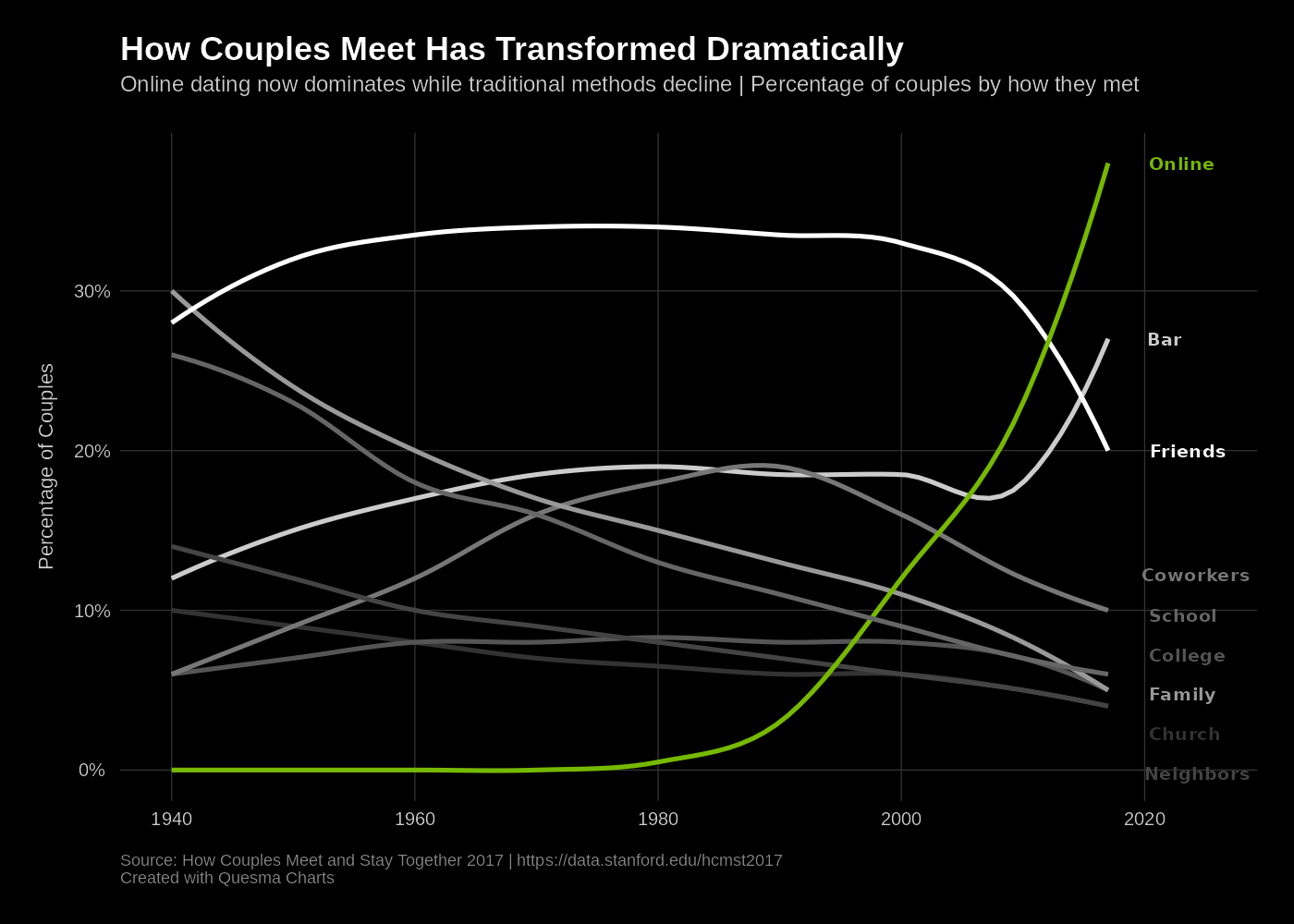
Context is in my recent blog post Which chart would you swipe right?, which discuss various ways of presenting a famous dataset How Couples Meet and Stay Together by Stanford. It's so intriguing that it's been visualized multiple times: by the original academic paper, The Economist, Statista, and crucially – here, r/dataisbeautiful.
I used Quesma Charts, an AI tool for creating charts with ggplot2 (full disclosure: I develop this tool). While I tried more normal ways, or appropriate for dating (e.g. kawaii style), I got curious to try something "off" – and prompted to look at as if it were from a presentation by Nvidia.
Posted by pmigdal
26 comments
Not enough misleading chart properties to be truly Nvidia like. but looks cool. How much did your leather jacket cost OP?
You need to include which country/countries were included in the survey in the chart.
The drop in “meet through friends” is huge.
It’s very hard to see, which label belongs to which line. And it also looks like there’s one more label than lines.
Ok but where’s the DLSS4 enabled curve
I’ve seen a variation of this graph for over 10 years, and it keeps bugging me – what does “met online” mean? Nowadays you can be friends, coworkers, classmates, and never have an offline interaction. For example, if you jump into an online lobby with your friends, your friend’s friend is there, and you hit it off – would it be categorized as “online” or “through friends”?
What I’m saying is, this data isn’t beautiful. I wish people would either stop or exercise some useful methodology. Maybe breaking “online” into tangible categories, meaningfully distinct from having a pre-existing non-romantic relationship, for starters.
So… there was at least some online dating in 1979, huh? OK, unless someone tells me otherwise, the graph has a bit of bullshit in it
Why are the tags for church through neighbors all off, with not even a line to point to what is what
Make a zootopia male genitals comparison chart in the style of NVIDIA now pls
Oh shiiit. I’ll give you 5000 dollary doos for one of those Online babies. Look at that sick curve!
This data is so unbeautiful it’s unreal, different shades of grey on grey? I can’t even tell which line ends with which category 😅
That online one needs to be about 50x higher.
that’s unfortunate. This means that a lot of couples get together based on superficial things due to online dating like Tinder which increases the likelihood of breakups and relationship satisfaction. Not saying that big part of men will remain single.
Can’t wait until online drops again cause to much AI bots, and people go back to real life approaching and meeting.
Great touch to use 6 different scales of grey, so nobody can actually match the lines with the labels at right.
Wait some of these couples are family?
I read somewhere that the rise of “Bar” is for people who met online and then went on a first date at a bar. There was a corrected graph somewhere that showed “Online” exploding even further.
in the style of Nvidia? you mean the whole thing is blatantly rigged to make the RTX 50 cards look like they’re actually worth buying?
The color coding is absolutely abysmal
while visually sort of pretty and clearly emphasizes the green line. The lack of distinguishing color for the other lines is problematic.
I think it’s unfortunate that this dataset apparently doesn’t differentiate between “dating apps” and “doing hobbies online”. I think it’s possible that a meaningful amount of the drop from “friends” to “online” could be due to people counting meeting someone through online acquaintances as “online” instead of as “friends”, and also more and more of life moving online.
This graph is 5 years old, I want new data.
The explanation for the uptick in “Bar” is clearly couples who met online but say they met at a bar.
Is it just me or do the values in 1940 add up to more than 100%?
I think the decline in matching through friends is part of a trend of later marriage and more mobility. As people in the 20s and 30s move around for college and work, their friend network becomes less stable. Combined with the growing reach of online, the friend-based matchmaking declined.
I am extremely dubious about the 10% meeting online in the late ’90s.
Comments are closed.